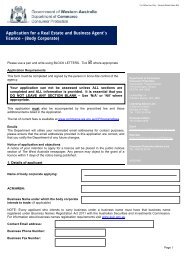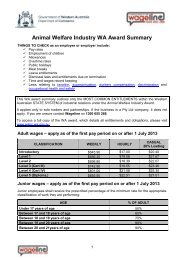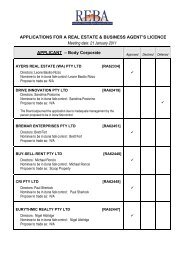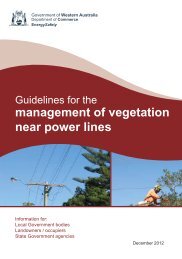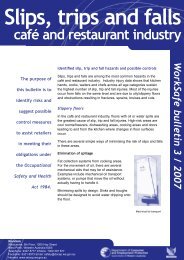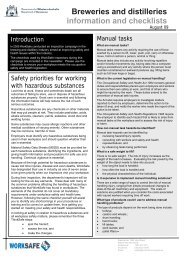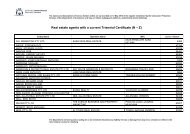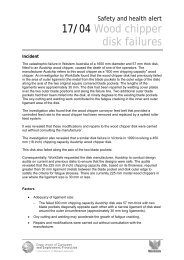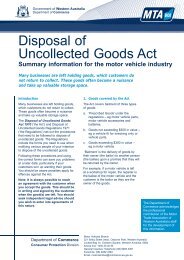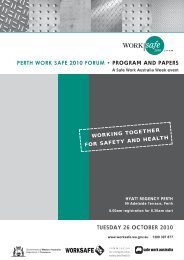Hexavalent chromium - Department of Commerce
Hexavalent chromium - Department of Commerce
Hexavalent chromium - Department of Commerce
Create successful ePaper yourself
Turn your PDF publications into a flip-book with our unique Google optimized e-Paper software.
<strong>Department</strong> <strong>of</strong> Consumer<br />
and Employment Protection<br />
Government <strong>of</strong> Western Australia<br />
WorkSafe<br />
SUMMARY PROJECT REPORT 2006/2007<br />
David Torr<br />
Christopher White<br />
Sally North<br />
Health Hazards and Plant<br />
Safety Branch<br />
<strong>Hexavalent</strong> <strong>chromium</strong> exposure in the electroplating industry<br />
TABLE OF CONTENTS<br />
1. Introduction 2<br />
2. Aims 3<br />
3. Implementation 3<br />
4. Methodology for Monitoring 3<br />
5. Results and Discussion 3<br />
6. Additional information 5<br />
7. Conclusion 5<br />
8. Recommendations 5<br />
Appendix: Breakdown <strong>of</strong> Improvement notices issued during project 7<br />
Page<br />
1
1. Introduction<br />
From December 2006 to May 2007 WorkSafe conducted a workplace inspection and monitoring<br />
project at various electroplating workplaces including those in the hard chrome, decorative<br />
chrome and zinc electroplating industries.<br />
1.1 Hazardous substances in electroplating<br />
The electroplating process involves the use <strong>of</strong> a range <strong>of</strong> hazardous substances including acids<br />
and solvents. Both chrome and zinc electroplating use hexavalent <strong>chromium</strong>, a known human<br />
carcinogen. Historically, high exposures to hexavalent <strong>chromium</strong> have been associated with a<br />
range <strong>of</strong> health effects from skin lesions (known as chrome sores), perforation <strong>of</strong> the nasal<br />
septum; skin and lung sensitisation through to cancer <strong>of</strong> the lung. The highest potential<br />
exposures to hexavalent <strong>chromium</strong> occur in the hard chrome plating industry followed by<br />
decorative chrome plating and to a lesser degree, zinc electroplating.<br />
1.2 Hazard controls ñ hexavalent chrome exposure<br />
Current controls used to reduce hexavalent <strong>chromium</strong> exposure in the electroplating industry<br />
centre on substitution, engineering, administration and personal protective equipment and<br />
clothing.<br />
1.21 Substitution<br />
The less toxic trivalent <strong>chromium</strong> can be substituted for hexavalent <strong>chromium</strong> with an associated<br />
reduction in health risk but cost and process limitations apply. The use <strong>of</strong> trivalent <strong>chromium</strong> in<br />
hard chrome plating is currently under trial in Australia and it anticipated that a practicable<br />
process will be available within a few years.<br />
1.22 Engineering controls<br />
Engineering controls involve the use <strong>of</strong> local exhaust ventilation (LEV) to capture and remove<br />
chromic acid mist from the tank surface in chrome plating (and acid mist in zinc electroplating).<br />
General ventilation (natural ventilation and/or fans in the ro<strong>of</strong>) is in place at many workplaces.<br />
This may dilute the contaminants in the air by means <strong>of</strong> drawing fresh air through the workplace,<br />
however the contaminants will still pass through the employeesí breathing zone, rather than being<br />
captured close to the tank as occurs when local extraction ventilation is used.<br />
1.23 Administrative controls<br />
Administrative controls include the use <strong>of</strong> surfactant (known as fume suppressant) to reduce the<br />
surface tension <strong>of</strong> the plating solution resulting in a significant reduction in the bursting <strong>of</strong><br />
hydrogen and oxygen bubbles that result in the production <strong>of</strong> the chromic acid mist. The dosing <strong>of</strong><br />
fume suppressant into chrome tanks is carried out on a manual or automated basis. Automatic<br />
pumps for dosing tanks with fume suppressant are available that monitor current draw in order to<br />
ensure that the required amount <strong>of</strong> fume suppressant is delivered as required and provide a more<br />
reliable (and economical) control over chromic acid mist generation than manual dosing alone.<br />
Other administrative controls required where there is a risk from chrome or hazardous substance<br />
exposure include:<br />
Health surveillance by an appointed medical practitioner (and weekly hand and forearm<br />
inspections by a competent person at the workplace)<br />
Personal hygiene procedures to ensure plating staff do not eat, drink or smoke on the<br />
plating lines (and wash hands before eating, drinking or smoking in designated areas)<br />
Procedures for confined space entry when cleaning plating tanks<br />
Spill and decanting procedures for the use <strong>of</strong> hazardous substances<br />
2
1.24 Personal protective equipment and clothing<br />
Personal protective equipment and clothing includes acid resistant clothing (long sleeves and<br />
trousers), splash pro<strong>of</strong> apron, respiratory protective devices, chemical resistant safety boots,<br />
gloves and appropriate eye protection (safety glasses, splash-pro<strong>of</strong> goggles or face-shield<br />
depending on the task).<br />
2. AIMS<br />
This project sought to assess occupational safety and health (osh) management in the<br />
electroplating industry by carrying out inspections at workplaces with particular reference to:<br />
<strong>Hexavalent</strong> <strong>chromium</strong> exposure control<br />
Hazardous substances management generally<br />
Other relevant priority areas (i.e. electricity, forklifts, guarding)<br />
3. IMPLEMENTATION<br />
Background research was carried out between October and November 2006 to determine the<br />
main hazards present in the electroplating industry and to gain an understanding <strong>of</strong> the processes<br />
involved. Seventeen electroplating companies were visited between December 2006 and April<br />
2007 and monitoring was conducted at six workplaces in May 2007.<br />
4. METHODOLOGY FOR ATMOSPHERIC MONITORING (WHERE CONDUCTED)<br />
The air monitoring was conducted with reference to:<br />
AS 3640 Workplace atmospheres<br />
NIOSH Method 7600<br />
Analysis was by the Chemistry Centre using ICPAES and colourimetry methods<br />
The results were compared to the Australian Exposure Standards for Atmospheric Contaminants;<br />
available at www.ascc.gov.au .<br />
Relevant Exposure Standards<br />
TWA: 50 µg/m 3 Chromium (VI) compounds (as Cr)<br />
500 µg/m 3 Chromium (metal)<br />
5. RESULTS AND DISCUSSION<br />
Number <strong>of</strong> investigations: 17<br />
Number <strong>of</strong> Improvement Notices: 250<br />
Number <strong>of</strong> Prohibition Notices: 5<br />
Number <strong>of</strong> workplaces where atmospheric monitoring was conducted: 6<br />
A breakdown <strong>of</strong> enforcement outcomes is provided in Appendix A. The principal issue identified<br />
within the electroplating industry related to inadequate identification, assessment and control <strong>of</strong><br />
hazardous substances hazards with 125 improvement notices issued for breaches in this area.<br />
3
5.1 Monitoring Results<br />
Table 5.1 Results For In Control Process ñ Personal Sampling <strong>of</strong> Electroplating Employees<br />
Type <strong>of</strong><br />
Electroplating<br />
Number <strong>of</strong><br />
Premises<br />
Monitored<br />
Range <strong>of</strong><br />
Results<br />
Approximate<br />
Total Cr<br />
µg/m 3<br />
Approximate<br />
Average<br />
Total Cr<br />
µg/m 3<br />
Range <strong>of</strong><br />
Results<br />
Approximate<br />
Cr (VI) µg/m 3<br />
Hardchrome 4 3 to 19 9.5 0.08 to 3.9 1.1<br />
Decorative Chrome 1 5 5 0.1 0.1<br />
Galvanising 1 1 to 1.5 1.3 Below the<br />
Limit <strong>of</strong><br />
Detection<br />
Table 5.2 Results For In Control Process ñ Static Area Sampling In Electroplating Work<br />
Area<br />
Type <strong>of</strong><br />
Electroplating<br />
Number <strong>of</strong><br />
Premises<br />
Monitored<br />
Range <strong>of</strong><br />
Results<br />
Approximate<br />
Total Cr<br />
µg/m 3<br />
Approximate<br />
Average<br />
Total Cr<br />
µg/m 3<br />
Range <strong>of</strong><br />
Results<br />
Approximate<br />
Cr (VI) µg/m 3<br />
Hardchrome 4 2 to 19 10 0.04 to 18.4 4.3<br />
Decorative Chrome 1 4.5 to 5.5 5 0.09 to 0.12 0.1<br />
Galvanising 1 Not<br />
Conducted<br />
Not<br />
Conducted<br />
Not<br />
Conducted<br />
Approximate<br />
Average<br />
Cr (VI) µg/m 3<br />
Below the<br />
Limit <strong>of</strong><br />
Detection<br />
Approximate<br />
Average<br />
Cr (VI) µg/m 3<br />
Not<br />
Conducted<br />
These results show at the time <strong>of</strong> monitoring, the levels <strong>of</strong> airborne chrome for ìin controlî<br />
processes were well below the exposure standards. It was noted that the ratio <strong>of</strong> <strong>chromium</strong> six to<br />
total <strong>chromium</strong> was fairly low, which may be due either to sampling other forms <strong>of</strong> <strong>chromium</strong> (eg<br />
from polishing operations) or due to reduction <strong>of</strong> <strong>chromium</strong> prior to analysis. This may mean that<br />
a larger proportion <strong>of</strong> the total <strong>chromium</strong> than tabled above is actually <strong>chromium</strong> six.<br />
Note that (with the exception <strong>of</strong> the galvanising workplace) the lowest atmospheric chrome levels<br />
found came from premises using relatively efficient local exhaust ventilation systems.<br />
5.2 Hard-chrome Workplace Monitoring<br />
Atmospheric monitoring <strong>of</strong> four premises involved with hard-chroming showed that for normal, in<br />
control processes the total chrome exposure for chrome shop employees ranged from 3 to 19<br />
µg/m 3 with the average being approximately 9.5 µg/m 3 .<br />
The hexavalent chrome exposure to employees ranged from 0.08 to 3.9 µg/m 3 with the average<br />
being approximately 1.1 µg/m 3 .<br />
Area monitoring near the tanks gave a range <strong>of</strong> 1.7 µg/m 3 to 19.4 µg/m 3 for total chrome with the<br />
average being 10.2 µg/m 3 . <strong>Hexavalent</strong> chrome area monitoring near the chrome tanks ranged<br />
from 0.04 µg/m 3 to 18.4 µg/m 3 with the average being 4.3 µg/m 3 .<br />
5.3 Decorative Chrome Workplace Monitoring<br />
Monitoring <strong>of</strong> one workplace showed the employeeís personal total chrome exposure was 5.1<br />
µg/m 3 . The employeeís level <strong>of</strong> exposure to hexavalent <strong>chromium</strong> was measured at 0.10 µg/m 3 .<br />
4
The total chrome range near the tanks was between 4.7 µg/m 3 and 5.3 µg/m 3 with an average <strong>of</strong><br />
5 µg/m. <strong>Hexavalent</strong> chrome levels in the air near the tanks ranged between 0.09 µg/m 3 and 0.12<br />
µg/m 3 , with an average <strong>of</strong> approximately 0.10 µg/m 3 .<br />
These levels are lower than the levels in hard-chrome workplaces, which is expected due to the<br />
process differences (lower current and shorter plating times).<br />
5.4 Galvanising Workplace Monitoring<br />
Total chrome was monitored for two employees with results <strong>of</strong> 1.0 µg/m 3 and 1.5 µg/m 3 giving an<br />
average <strong>of</strong> approximately 1.25 µg/m 3 . <strong>Hexavalent</strong> chrome was below the detection limits. These<br />
levels are lower than those at hard-chrome or decorative chrome workplaces, which is to be<br />
expected due to the lower concentration <strong>of</strong> <strong>chromium</strong> used in the process.<br />
Due to the nature <strong>of</strong> the workplace it was not considered practicable to take a positional sample<br />
(risk <strong>of</strong> damage to equipment and inconvenience to workplace).<br />
6. ADDITIONAL INFORMATION<br />
Evidence <strong>of</strong> chromic acid mist fall out (ìbrown outî) was present in most hard chrome plating<br />
workplaces, characterised by a film <strong>of</strong> brown dust throughout the workshops. The presence <strong>of</strong><br />
chromic acid fall out indicates a loss <strong>of</strong> control <strong>of</strong> fume suppressant and/or inadequate local<br />
extraction ventilation (LEV). Premises that had reasonably efficient LEV appeared to have<br />
significantly less brown dust in the chroming area. Temperature monitoring and systems <strong>of</strong> work<br />
that help control temperatures clearly helps reduce the risk <strong>of</strong> ìbrown outsî.<br />
7. CONCLUSION<br />
Whilst the atmospheric monitoring results gave low chrome airborne levels during normal work<br />
processes (well below the exposure standards), discussions with industry staff and evidence <strong>of</strong><br />
ìbrown-outsî indicate that on occasion, many workplaces still lose control <strong>of</strong> the chroming<br />
process, increasing the risk <strong>of</strong> hexavalent chrome exposure to persons in the area. The most<br />
effective control measure based on the results was found to be an efficient local exhaust system<br />
This project has determined that the general level <strong>of</strong> osh awareness and osh management<br />
throughout the electroplating industry needs significant improvement. The current project has<br />
resulted in significant enforcement action in relation to the use <strong>of</strong> hazardous substances (as well<br />
as other WorkSafe priority areas) and increased osh awareness throughout the industry.<br />
8. RECOMMENDATIONS<br />
These recommendations take into consideration that many workplaces may occasionally have a<br />
loss <strong>of</strong> control <strong>of</strong> their tanks with resultant chrome mist ìbrown-outsî and that hexavalent<br />
<strong>chromium</strong> is carcinogenic, therefore exposure should be reduced as far as practicable. WorkSafe<br />
recommends:<br />
1. That workplaces ensure that their chrome plating tank systems as<br />
far as practicable minimise the risk <strong>of</strong> loss <strong>of</strong> temperature control.<br />
2. Chrome plating workplaces note that local extraction ventilation in<br />
conjunction with automatic surfactant dosing represents best<br />
practice in control <strong>of</strong> atmospheric <strong>chromium</strong>, and where practicable<br />
implement both <strong>of</strong> these controls.<br />
5
3. Where a local extraction ventilation system is installed, air flow is<br />
tested to ensure the capture velocity is adequate across the chrome<br />
mist generation area (eg a minimum <strong>of</strong> 0.5 metres per second<br />
across all points <strong>of</strong> the tank). Records <strong>of</strong> such ventilation testing<br />
and any maintenance work carried out on the LEV should be kept.<br />
4. Chrome plating workplaces should incorporate automatic dosing <strong>of</strong><br />
fume suppressant. Where a manual dosing system is used it will be<br />
required by WorkSafe that clear records are kept indicating when<br />
doses were added and the quantity <strong>of</strong> the doses.<br />
5. Where a ìbrown-outî event or loss <strong>of</strong> control occurs such that<br />
chrome mist levels in the breathing air are likely to be high,<br />
including where workers are returning after days <strong>of</strong>f to reopen<br />
premises, then there should be a plan to safely deal with this<br />
including protecting any person required to enter such an<br />
environment. Prior to entering such environments, persons required<br />
to activate ventilation, dosing and other controls to improve the<br />
working environment for the entry <strong>of</strong> others should have ready<br />
access to respirators and personal protective equipment complying<br />
with the appropriate Australian Standards. The procedure should<br />
also address adequate ventilation prior to the entry <strong>of</strong> other<br />
employees, and decontamination/showering for employees entering<br />
the workplace under ìbrown-outî conditions.<br />
6. Employers at electroplating workplaces should familiarise<br />
themselves with the types <strong>of</strong> breaches identified during this project<br />
(Appendix A) and develop systems (e.g. workplace inspections,<br />
toolbox meetings) to manage these osh issues in consultation with<br />
employees.<br />
Refer to the guidance material ìControlling Hazards in the<br />
Electroplating Industryî (enclosed), WorkSafeís website<br />
www.worksafe.wa.gov.au , or contact WorkSafe on 9327 8777 for<br />
further advice on osh issues.<br />
___________________________________________________________________________<br />
6
Appendix A: Number <strong>of</strong> notices issues for different breaches<br />
Section or<br />
Regulation<br />
Description <strong>of</strong> breach Number<br />
Hazardous Substances Register/MSDS 10<br />
Hazardous Substances Risk Assessment/ Risk Assessment Report 12<br />
Hazardous Substances Risk Assessment Report 10<br />
Hazardous Substances Training 12<br />
Hazardous Substances Labelling 8<br />
Hazardous Substances Storage 2<br />
Hazardous Substances Health Surveillance ñ <strong>Hexavalent</strong> Chromium 13<br />
Hazardous Substances Spills Procedure 7<br />
Hazardous Substances Decanting Procedure 6<br />
Hazardous Substances ñ chrome plating ñ records <strong>of</strong> fume<br />
suppressant dosing<br />
4<br />
Hazardous Substances ñ personal hygiene ñ consumption <strong>of</strong><br />
foodstuffs<br />
9<br />
Emergency shower/eyewash (fit/repair) 10<br />
Provision/use/maintenance <strong>of</strong> Personal Protective Equipment and 10<br />
Clotting<br />
Evacuation 2<br />
Confined space entry procedures 14<br />
Edge protection (especially caustic tanks and mezzanine floors) 13<br />
Bench Grinders (signage/guarding) 9<br />
Isolation <strong>of</strong> plant 12<br />
Emergency stops on plant 2<br />
Guarding <strong>of</strong> plant 3<br />
Air receiver registration and inspection 4<br />
Gantry / hoist maintenance 5<br />
Certificate <strong>of</strong> competency ñ dogging 1<br />
Certificate <strong>of</strong> competency ñ forklift 6<br />
Forklift maintenance 9<br />
Forklift maintenance records 3<br />
Forklift operators manual 6<br />
Forklift (operating on rough surfaces) 1<br />
Forklift wearing <strong>of</strong> seat belts 2<br />
Electrical RCD 6<br />
Electrical maintenance 12<br />
Fire fighting equipment 2<br />
General housekeeping 3<br />
Slippery surfaces 2<br />
Slips trips and falls 4<br />
Smoking in the workplace 2<br />
General induction 2<br />
General risk assessment 2<br />
Damaged lifting slings 1<br />
Unsecured pallet racking 2<br />
Flashback arrestors 2<br />
Secure gas cylinders 1<br />
First aid 1<br />
Sandblasting 3<br />
Total 250<br />
7



